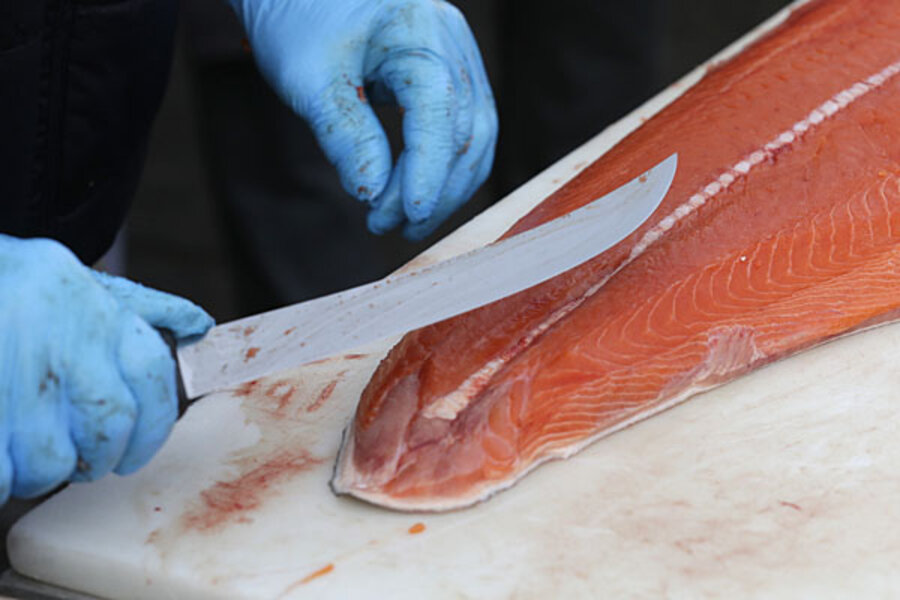Is sustainable farm-raised salmon possible?
Loading...
Verlasso, a joint venture from AquaChile and Dupont, is the first ocean-raised farmed Atlantic salmon to receive the Good Alternative recommendation from the Monterey Bay Aquarium's Seafood Watch program. The Chilean-based farm aims to produce salmon with minimal impact on the environment. Verlasso has reduced the amount of fish necessary to feed their salmon by 75 percent. Scott Nichols (SN), a director at Verlasso, explains how they were able to accomplish this and how aquaculture may be changing.
FT: What sets Verlasso apart from other salmon producers?
SN: We work simultaneously on improving practices in salmon aquaculture so that we raise our fish in harmony with the environment. Our goal is to develop practices that help us have salmon in seven generations, not just the immediate future. Salmon, whether wild or farmed, get their omega-3s from their diet. Farmed salmon are fed diets that contain omega-3 rich fish oil rendered from wild fish such as anchovies. The problem is that it takes about four pounds of captured wild feeder fish to provide the fish oil required to raise one pound of salmon. This means that for every ton of increase in our worldwide production of salmon, we need to increase our capture of feeder fish by four tons. Such heavy dependency on wild fish puts extreme pressure their populations. Verlasso has decreased the fish in to fish out ratio for fish oil by 75 percent. We do this by feeding the fish a yeast that makes the essential omega-3s.
FT: Verlasso salmon is more expensive than most salmon—is it worth the price?
SN: How your food is raised matters. It is something you will notice on your plate. The Patagonian waters of Chile provide ideal conditions for growing salmon. The waters are sixty to eighty meters deep with strong tidal flow; they are free of contaminants. Our pens lie fallow after each harvest for three to six months providing the water the opportunity to rejuvenate and recycle. The fish are given maximum space in which to grow with 98.8 percent water and only 1.2 percent salmon in the pens. This cuts industry standards in half. Verlasso is a delicious fish with a bright and delicate flavor that is different from traditionally farmed salmon. It has slightly more fat than wild salmon though less than traditionally farmed salmon, and higher moisture content, giving it a buttery yet firm texture.
FT: Do you see your techniques catching on with other fish producers in the future?
SN: Aquaculture is changing rapidly. There are many changes happening as farmers learn and grow. We are not at all alone in wanting to improve aquacultural practices and would like to lead by example.
FT: What is on the horizon for Verlasso this year and in the next few years?
SN: In addition to supporting our existing distributors, chefs, and smaller retail chains, we are beginning to serve larger, national grocery retailers. Our move to establish national availability is exciting for us and helps in our goal to make sustainably raised salmon available across a wide range of demographics and geographies.
FT: What is the biggest challenge you face as a producer?
SN: Our environmental efforts and our stewardship of wild fisheries are not apparent simply by looking at our fish. We need to tell the Verlasso story to the folks standing in front of the seafood counter. When we began at small retailers we could do this by being present at the seafood counter to talk with the fishmongers and the customers. As we move to a national presence the need to tell our story is the same but the scale is significantly larger.
FT: What will it take to make the entire fish production system sustainable?
SN: Aquaculture must result in net production of fish. Wild fish such as anchoveta, sardines, and mackerel are caught, rendered to fish oil and fish-meal and subsequently included in the diets of farmed fish. As I mentioned above, dependency of aquaculture on these wild fisheries must be broken.
Aquaculture must not deplete. Both biodiversity and the environment must be maintained or retained at and near farm sites. Farms must be sited away from fragile ecosystems and the vagaries of interaction between farms and the local environment must be discerned. Farms must not be placed in areas of high carbon sequestration. All agriculture, whether land or water-based, has effects on the environment. In the case of aquaculture, effluents in their many guises must be controlled so that they do not adversely affect the environment. If we address these, we will be on a very good pathway to be able to have fish in seven generations.







